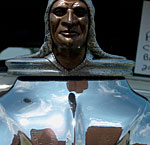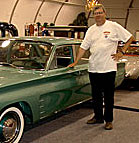Revved up over Pontiacs
By Elizabeth Stawicki, Minnesota Public Radio
July 20, 2001
Automobile enthusiasts from around the nation have brought their show cars to Red Wing this weekend for the national Pontiac owners' convention. This year is special because the brand is celebrating its 75th anniversary. To call these car owners enthusiasts is an understatement.
THE PONTIAC OWNERS CONVENTION INVITATIONAL attracts everyone from hard-core motorheads to those who just like to looking at beautifully restored cars. For many, not just any car will get their motors revving; it's got to be a Pontiac.
"They're the Harley Davidson of cars," says Marty Willis, who drove his 1971 Pontiac GTO from Brandon, S.D. He's owned 17 GTOs.
"These are the cars we grew up with," he says. "Some of these guys bought these things out of high school. We were buying them when they were 6,7 years old. Everybody wants to go back and live like they were as a teenager when they figure out how boring life really becomes. They want to come and live it over again."
These owners have restored their cars to such pristine condition that they're actually better than new. Cars typically leave the factory with little imperfections, such as paint oversprays. But owners like Bob Powell, from Delaware, make up where Detroit left off. Powell hangs over the open hood of his 1966 Bonneville convertible and is painting the car's engine "because Pontiacs have a tendency to burn the paint off the heads, so I'm just touching it up to make it look better for the show. It turns color, the rest of it silver and metallic," he says.
The idea that people like Powell so lovingly restore a Pontiac today might've seemed absurd back in the 1950s.
Then, the ailing brand was in serious danger of collapse. So in 1956, General Motors brought in Bunkie Knudson to revamp the brand's "grandpa car" image. He stripped Pontiacs of their signature silver streaks, a pair of vertical chrome lines on the hood that Knudson said looked like suspenders. For the next several years, Pontiac tried to build a new image of exciting, fast cars that would appeal to young people.
Pontiac expert John Gunnell, says Pontiac succeeded in large part by building high-performance cars that won on the race track. "From 1960 to 1970, Pontiac went from being 4th or 5th or 6th in sales to being third in sales behind Ford and Chevrolet and turned Pontiac into a major company. Pontiac was well known for racing in the early '60s, and because they won on Sundays, they sold on Mondays, and made Pontiac very successful," according to Gunnell.
At the same time, engineers also developed the GTO behind the backs of General Motor's top brass. After deadly crashes on and off the racetrack and intense pressure by AAA, GM banned all its divisions from building hot-rod cars and supporting racing in 1963.
But Pontiac engineers still tinkered and dropped a full-sized car engine into a mid-sized car to see how it would run. It ripped from 0 to 100 mph in less than 12 seconds.
GM engineer and Pontiac's official historian, John Sawruk, says engineers skirted GM's ban on high-performance cars by introducing the GTO as an option on another car, the LeMans. "They didn't have to go downtown to get it approved by the corporation, so they were able to have 5,000 initial orders without the corporation even knowing they were going to make this car. They didn't know it was a GTO at the time," Sawruk says.
It was an immediate hit. Sales went crazy and a year later - in 1965 - GTO became a car on its own.
Bob Iverson loves the sound of his 1965 GTO, but it's so important to him that he shipped it on a flatbed from his Niles, Ill., home so the car wouldn't rack up extra mileage. For Iverson, this car heals some old wounds by bringing back lost time. "In 1965, I owned a brand new one for two months and then got drafted to Vietnam and had to sell it. I couldn't afford it until I became an old man," he says.
The outlook is dim, however, for young people taking the same kind of interest in these cars. Enthusiasts say young people can't afford the high price tags of restoring these cars when they can modify less expensive, Japanese automobiles.
By Elizabeth Stawicki, Minnesota Public Radio
July 20, 2001
|
|
RealAudio |
| |
|
|
|
||
THE PONTIAC OWNERS CONVENTION INVITATIONAL attracts everyone from hard-core motorheads to those who just like to looking at beautifully restored cars. For many, not just any car will get their motors revving; it's got to be a Pontiac.
"They're the Harley Davidson of cars," says Marty Willis, who drove his 1971 Pontiac GTO from Brandon, S.D. He's owned 17 GTOs.
"These are the cars we grew up with," he says. "Some of these guys bought these things out of high school. We were buying them when they were 6,7 years old. Everybody wants to go back and live like they were as a teenager when they figure out how boring life really becomes. They want to come and live it over again."
These owners have restored their cars to such pristine condition that they're actually better than new. Cars typically leave the factory with little imperfections, such as paint oversprays. But owners like Bob Powell, from Delaware, make up where Detroit left off. Powell hangs over the open hood of his 1966 Bonneville convertible and is painting the car's engine "because Pontiacs have a tendency to burn the paint off the heads, so I'm just touching it up to make it look better for the show. It turns color, the rest of it silver and metallic," he says.
The idea that people like Powell so lovingly restore a Pontiac today might've seemed absurd back in the 1950s.
| |
|
|
|
||
Pontiac expert John Gunnell, says Pontiac succeeded in large part by building high-performance cars that won on the race track. "From 1960 to 1970, Pontiac went from being 4th or 5th or 6th in sales to being third in sales behind Ford and Chevrolet and turned Pontiac into a major company. Pontiac was well known for racing in the early '60s, and because they won on Sundays, they sold on Mondays, and made Pontiac very successful," according to Gunnell.
At the same time, engineers also developed the GTO behind the backs of General Motor's top brass. After deadly crashes on and off the racetrack and intense pressure by AAA, GM banned all its divisions from building hot-rod cars and supporting racing in 1963.
But Pontiac engineers still tinkered and dropped a full-sized car engine into a mid-sized car to see how it would run. It ripped from 0 to 100 mph in less than 12 seconds.
GM engineer and Pontiac's official historian, John Sawruk, says engineers skirted GM's ban on high-performance cars by introducing the GTO as an option on another car, the LeMans. "They didn't have to go downtown to get it approved by the corporation, so they were able to have 5,000 initial orders without the corporation even knowing they were going to make this car. They didn't know it was a GTO at the time," Sawruk says.
| |
|
|
|
Bob Iverson loves the sound of his 1965 GTO, but it's so important to him that he shipped it on a flatbed from his Niles, Ill., home so the car wouldn't rack up extra mileage. For Iverson, this car heals some old wounds by bringing back lost time. "In 1965, I owned a brand new one for two months and then got drafted to Vietnam and had to sell it. I couldn't afford it until I became an old man," he says.
The outlook is dim, however, for young people taking the same kind of interest in these cars. Enthusiasts say young people can't afford the high price tags of restoring these cars when they can modify less expensive, Japanese automobiles.


